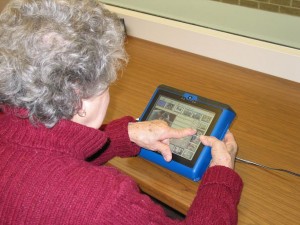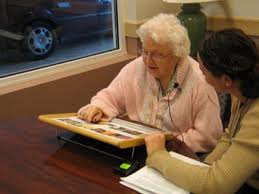An In-Depth Look at Aphasia
Overview
Aphasia is an acquired communication disorder that results from damage to the brain, most often from a stroke. Adults are more frequently afflicted with aphasia due to the cause of the disorder; however, children may also acquire aphasia. Other causes may include an infection, head trauma, or brain tumor.
Aphasia does not impair the intelligence of the patient. However, the patient with aphasia has trouble processing language, and so speaking even simple words and sentences may feel like a “giant leap for mankind.” The symptoms of aphasia can range from mild to severe, depending on the specific pattern or type of aphasia that the patient has.
Anomic Aphasia
Patients with anomic aphasia understand written and spoken language well. However, they have difficulty finding the right words to take part in a conversation and express their needs and wants. In particular, patients with anomic aphasia may leave out the major nouns and verbs in a sentence. For example, instead of saying “I will eat the spaghetti at the table in my favorite chair,” the patient may say “I will at the in my.” This speech disorder is essentially characterized by a difficulty with naming items and actions.
Broca’s Aphasia
In contrast to anomic aphasia, patients with Broca’s aphasia may be able to speak short, but meaningful sentences. While these patients may understand speech well, they have great difficulty in producing words. They may only be able to speak a noun and a verb, and they will leave out all other words. For example, the patient may say “Pet cat.” Caregivers may have difficulty interpreting whether the patient is asking where the cat is, whether he can pet the cat, or whether someone owns a pet cat.
Mixed Non-Fluent Aphasia
Mixed non-fluent aphasia is similar to Broca’s aphasia. Patients speak in short groups of words sparingly and with great effort. While patients with Broca’s aphasia can still understand other people’s speech well, those with mixed non-fluent aphasia process spoken language in a limited manner. They also tend to have more difficulty reading and writing.
Wernicke’s Aphasia
Patients with Wernicke’s aphasia have great difficulty understanding the speech of themselves and others. However, unlike other types of aphasia, they can speak without great effort. The problem lies in the sentence composition and meaning. Patients with Wernicke’s aphasia often produce long sentences that are virtually incomprehensible. They frequently produce nonsense words or irrelevant words.
Global Aphasia
Patients with global aphasia have the most severe type of the disorder. They either cannot understand spoken language at all or they understand very little of it, nor can they read or write. Some patients with global aphasia may be able to speak a very small number of words. Sometimes, if the damage to the brain is not terribly severe, the patient may improve rapidly following the injury or stroke.
Diagnosis
A speech-language pathologist (SLP) will diagnose a patient with aphasia by evaluating his communication skills and the coordination and strength of the muscles used for speech. The SLP may ask the patient basic questions to assess whether he understands the question and can respond fluently. For example, the SLP may ask the patient what his name is.
If the patient displays basic communication skills, the SLP may progress to using longer passages of speech that increase in complexity. The SLP will also assess the patient’s ability to read and write progressively more complex words and sentences.





